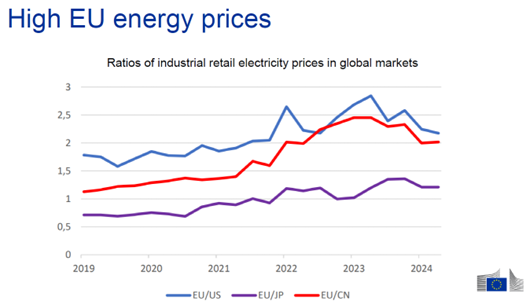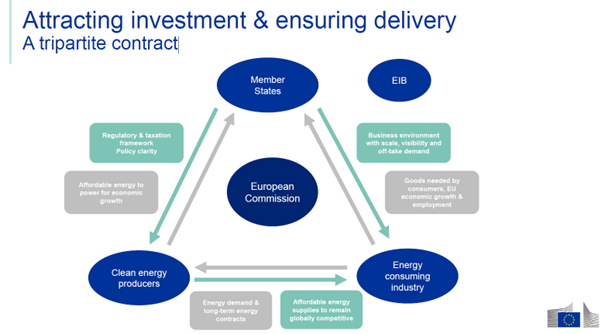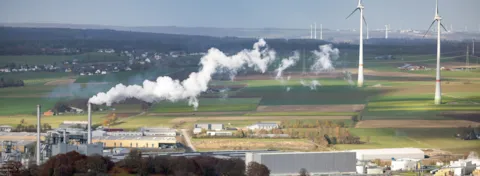The EU clean industrial deal: Will Europe lead the next industrial revolution?
From the planet and stakeholders to your value chain, pressure is continually increasing. So too are the new business opportunities that many companies experience once energy and emissions shift from a cost centre to a new business model. Meanwhile, energy-intensive and other industries in Europe face growing pressure to stay competitive, as they contend with high energy prices, rising grid tariffs, and the necessary investments required for decarbonization — all while energy availability and affordability have become critical concerns. Will the Clean Industrial Deal (CID) released in February 2025 bring the relief and guidance many are looking for?
The impressive past and future of Europe’s industrial journey
Europe has a unique industrial history, having brought the world the Industrial Revolution, where Great Britain was initially leading the pack in the 1760's. This revolution introduced and globally scaled many efficient and stable manufacturing processes; however, the great head start in the end came with a legacy of complicated environmental setbacks, including the highest cumulative footprint worldwide created by two and a half centuries of greenhouse gas emissions.
Today, EU industries face increasing challenges to stay competitive while energy availability and affordability have become key. Energy prices are two or more times higher than those in the USA or China. Rising grid transport fees to cover the electrification infrastructure investments are increasing this gap even further. Fears of a possible industry shakeout in Europe are shared by #industry leaders and politicians. Amidst this turmoil, the acceleration towards #zero #emissions can be perceived as a lesser priority.

As a response, the European Commission has introduced the CID to enable the competitiveness and decarbonization of industries. It focuses on energy-intensive industries that require urgent support to decarbonize and electrify, in addition to placing clean tech at the heart of future competitiveness and growth. The aim is to achieve lower energy costs, attract investment, and ensure delivery. At the core is a tripartite contract between energy-consuming industries, the Member States, and clean energy producers.
Whether the CID proves to be the game-changer many are anxiously and urgently waiting for remains to be seen. Hopes are high; it could well be the right framework and tool at the right time. The plan is here; it is now up to the Member States to show leadership and take the initiative towards industry and energy producers. Today, not tomorrow.
EU energy prices are over two times higher than those in the USA or China
What is happening today?
To have the CID succeed at the Member State level, finding solutions to the main complications is a must. Solving the hurdles could accelerate Europe towards a clean and competitive industry. But first, it helps to understand the main challenges.
Decarbonization and competitiveness, the two main CID elements, are very much intertwined in the long term to create value and industries' license to operate. However, they may complicate some investment decisions, technology selection, and implementations in the short term. Also, the willingness to pay for environmentally friendly products is increasing overall, although often still in niche markets.
Secondly, the Member States, industries, and energy sectors are now key in adopting and actively following up on the CID. All members, not only those with many energy-intensive industries, as all energy-consuming industries are affected, play a role here in ensuring a future-proof Europe.
Thirdly, in some countries, the electricity grid is not coping with the electrification of industries and households. Significant grid infrastructure investments are needed, with some grid operators predicting costs that could reach €10,000 or more per tax-paying resident in the coming years! These costs represent the pessimistic scenario, but they nevertheless justify investing also in other electrification solutions. And fortunately, these do exist.
Last but not least, there is a general lack of industry policy guiding us which industries are considered part of a future-proof, safe, and more independent EU, and which industries are not. This is needed but is tricky as any advice or decision will lead to strong protest and likely legal actions from the sectors not being on top of the list. However, these discussions are now taking place where they were taboo until recently. This may lead to new insights and possible additional supportive frameworks for specific industries and European regions.
Are we willing to decide which industries are key to our EU independence, economy, and safety? To agree on which EU regions offer specific industries the long-term potential in those regions – or anywhere in the EU where these industries are currently located. Here the EU should follow the path of maximizing value creation of its industry portfolio and wisely balance with needed commodities to increase Europe’s resilience.
Are we willing to decide which industries are key to our EU independence, economy, and safety, and which are not?

Make it happen, again!
Low or carbon-free products are creating new markets and demand is rising steadily, with markets like food, metal, and the clean-tech sector leading the way.
The first significant steps have been made through energy efficiency and technologies from renewable electrification to heat pumps, alternative fuels, and more. However, achieving zero emissions requires significant additional investments in industrial production facilities and in many regions additional public (energy) infrastructure.
Recent geopolitical changes have placed us at a crossroads: to become less dependent on others for energy, materials, and safety, or not. The energy transition and renewables offer a unique momentum towards more independence and attractive energy prices. The levelized cost of renewable energy including storage (LCOE) is beating fossil energy.
The EU Carbon Border Adjustment Mechanism (CBAM) is maturing, working out the kinks, and even if far from perfect, is creating a more level playing field for EU industries.
For countries facing major grid investments to cope with electrification, solutions may arrive sooner than expected. Recent developments prove that smart grid management, including demand-side response incentives, can solve a major part of the congestion and connection problems, with a short lead time and at a fraction of the physical grid expansion costs. Both the (limited) grid expansion and smart grid pathways should be executed where the economy and industry are at stake.
It is now up to the Member States to act, lead, and unite energy-consuming industries and clean energy producers. To select strategic net-zero technologies and support domestic production. It is expected that countries will move at different speeds as usual when adopting EU policies.
Deciding which industries are viable in a clean, affordable, and safe Europe is tough and full of resistance. As the topic has moved rapidly from a long-term taboo to an open and valid discussion, it could well have a real impact on industry policies or incentives in the coming years.
Europeans are creative and have the third largest continental economy with a strong presence in advanced manufacturing, digital and financial services while also leading globally in emission reduction and life expectancy. The EU's industry accounts for a whopping 23% of GDP, achieved by people with many different cultures and languages working together in a turbulent world.
I am confident about a competitive and emission-free Europe if we use today’s pressure cooker to unite and move forward. Europe’s 450 million inhabitants can and will make the difference, as several generations before us have also done. It will not fly without effort, but Europe can make it happen - this time with clean and competitive industries making a global positive impact.
7/8/2025 7:00:00 AM
